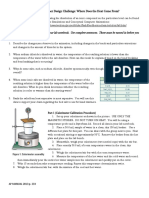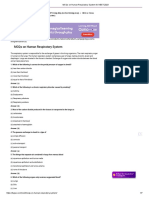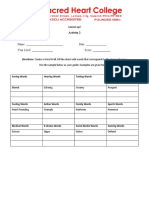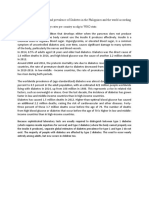Exp1 The Solubility of A Salt
Exp1 The Solubility of A Salt
Uploaded by
somon pierre GAHIMBARECopyright:
Available Formats
Exp1 The Solubility of A Salt
Exp1 The Solubility of A Salt
Uploaded by
somon pierre GAHIMBAREOriginal Description:
Original Title
Copyright
Available Formats
Share this document
Did you find this document useful?
Is this content inappropriate?
Copyright:
Available Formats
Exp1 The Solubility of A Salt
Exp1 The Solubility of A Salt
Uploaded by
somon pierre GAHIMBARECopyright:
Available Formats
lOMoARcPSD|22908223
Exp.1 The Solubility of a Salt
Engineering Thermofluids (University of Windsor)
Studocu is not sponsored or endorsed by any college or university
Downloaded by Simon Pierre Gahimbare (sgahimbare246@gmail.com)
lOMoARcPSD|22908223
CHEM 1103 2021 Experiment 1
EXPERIMENT 1
An Introduction to Data Collection: The Solubility of a Salt
Objectives
Become familiar with data collection and analysis using a temperature probe and LabQuest data
collection software.
Collect the experimental data necessary to construct a solubility curve for potassium chloride in
water.
Background
Solubility is an important physical property in chemistry which describes the amount of solute that
dissolves in a given amount of solvent. The solubility of chemical compounds varies extremely and can
be affected by factors such as pressure, temperature, pH, and intermolecular forces or interionic forces
in both the solute and the solvent. For most ionic compounds, solubility varies directly with
temperature, thus, solubility is often expressed as the mass of solute that dissolves in 100 g of water at
a particular temperature.
A saturated solution is a solution that contains the maximum amount of dissolved solute at a
given temperature. In this type of solution dissolution and precipitation are occurring at the same rate,
thereby satisfying the requirement for a dynamic equilibrium. Two statements can be made about this
solution: (1) the two processes, dissolution and precipitation, are going on at the same time, and (2)
the number of molecules or ions in the solution remains constant. For example, the equilibrium of
sodium chloride with its ions in a saturated solution would be shown by the equation
NaCl(s) Na+(aq) + Cl-(aq)
An unsaturated solution contains less solute than does a saturated solution, i.e., no equilibrium
is present. When additional solute is added to an unsaturated solution, it dissolves. When additional
solute is added to a saturated solution, the amount of dissolved solute does not increase, because the
limit of solubility has already been reached. A super saturated solution contains more than the
maximum amount of dissolved solute than a saturated solution under the same conditions. Since
solubility often varies with temperature a solution that is saturated at one temperature may be
unsaturated at a different temperature. As well, temperature changes may cause a saturated solution
to become super saturated.
In this experiment, you will collect data using temperature probe and LabQuest interface to
investigate the effect of changing temperature on the amount of potassium chloride (KCl) that will
dissolve in a given amount of water. You will completely dissolve different known quantities of KCl in
the same volume of water at a high temperature. As each solution cools, you will monitor temperature
and record the precise temperature at which solid crystals start to form. At this moment, the solution
is saturated and contains the maximum amount of solute at that temperature. Each data pair consists
of a solubility value (g of solute per 100 g H 2O) and a corresponding temperature. A graph of the
temperature-solubility data, known as a solubility curve, can be obtained. Solubility curves are used to
1 of 7
Downloaded by Simon Pierre Gahimbare (sgahimbare246@gmail.com)
lOMoARcPSD|22908223
CHEM 1103 2021 Experiment 1
predict the mass of solute in water at any given temperature. Typical solubility curves are shown in
Figure 1.1. Here solid lines represent saturated solutions. Unsaturated solutions exist below the solid
line, whereas super saturated solutions exist above the solid line.
Figure 1.1 Typical Solubility Curves
Glassware & Equipment
Balance Test tubes: 5 (18 x 150 mm)
Beakers: 250 & 400 mL Test tube rack
Graduated cylinder: 10 mL Utility clamps (2)
Hot plate Vernier LabQuest interface
Retort stand Vernier Temperature probe
Stirring rod Weighing funnel and spatula
Chemicals
Potassium chloride (KCl)
Procedure
1. Power-on the LabQuest unit (top left power button). The LabQuest App launches automatically.
Connect a temperature probe to the CH 1 port. The LabQuest App will auto-ID the connected
sensor and a live reading will appear in the Meter screen.
2 of 7
Downloaded by Simon Pierre Gahimbare (sgahimbare246@gmail.com)
lOMoARcPSD|22908223
CHEM 1103 2021 Experiment 1
2. Set up the data-collection mode: On the Meter screen, tap Mode. Change the mode to Events
with Entry. Enter the Name (Solubility) and Units (g/100g). Select OK.
3. Fill a 400 mL beaker three-fourths full of tap water. Place it on a hot plate situated on (or next
to) the base of a retort stand (watch for hot plate power cord not to touch the hot surface).
Heat the water bath to about 90°C and adjust the heat to maintain the water at this
temperature. Place the temperature probe in the water bath to monitor the temperature and
to warm the probe. To keep from damaging the temperature probe wire, hang it over another
utility clamp pointing away from the hot plate, as shown in Figure 1.2.
Figure 1.2 Equipment Set-up
4. Use the weighing funnel, measure out the amount of KCl required for the first test tube as
shown in the second column of Table 1.1 from your Data Sheets (amount per 5 mL). Record the
exact mass with the correct number of decimal places. Transfer to a clean and dry test tube.
5. Add precisely 5.0 mL of distilled water to the test tube, measured from a 10-mL graduated
cylinder. Note: The fourth column in Table 1 (amount per 100 g of H 2O) is proportional to your
measured quantity and is the amount you will enter for your graph in Step 7. Calculate this
value before proceeding. Assume 1.0 g/mL for the density of water.
6. Use a utility clamp to fasten the test tube to the retort stand. Lower the test tube into the
water as shown in Figure 1.2. Use a stirring rod to stir the mixture until the KCl is completely
dissolved. Note: In order to dissolve all the KCl, Test Tubes 3 and 4 need to be heated to a higher
temperature than Test Tubes 1 and 2.
7. You are now ready to collect temperature-solubility data:
i) When the salt is completely dissolved, remove the temperature probe from the water bath,
wipe it dry, and place it into the solution in the test tube.
ii) Tap Collect to start the data collection.
iii) Unfasten the utility clamp holding the test tube from the ring stand. Use the clamp to hold
the test tube up to the light to look for the first sign of crystal formation. At the same time,
stir the solution with a slight up and down motion of the temperature probe. Note: Test
tubes 1 and 2 may be cooled to lower temperatures using cool tap water in a 250 mL beaker.
This drops the temperature much faster than air. If the crystals form too quickly, briefly
warm the test tube in the hot-water bath and re-dissolve the solid. Then repeat the cooling
and collect the data pair.
3 of 7
Downloaded by Simon Pierre Gahimbare (sgahimbare246@gmail.com)
lOMoARcPSD|22908223
CHEM 1103 2021 Experiment 1
iv) Now crystallization starts to occur, tap Keep . Enter the mass in grams (the solubility
value in column 3 of Step 1, g per 100 g H2O). Select OK to store the temperature-mass data
pair.
v) After you have saved the temperature-mass data pair, return the test tube to the test tube
rack and place the temperature probe in the water bath for the next trial.
8. Repeat Steps 4 – 7 for each of the other four samples listed in Table 1.1.
9. When you have collected the last data pair, stop data collection by pressing the red stop button
(lower left corner of the screen).
10. Data for columns 3 and 5 in Table 1.1 will be provided. Record these values in your Data Sheets.
10. Use the provided grid in the Data Sheets to plot solubility (grams KCl/ 100 g water) on the Y-Axis
and the corresponding temperature on the X-Axis. Add a title to your plot and correctly label
the axes.
4 of 7
Downloaded by Simon Pierre Gahimbare (sgahimbare246@gmail.com)
lOMoARcPSD|22908223
CHEM 1103 2021 Experiment 1
Name: Section:
REPORT SHEETS – EXPERIMENT 1
An Introduction to Data Collection: The Solubility of a Salt
Data and Results [2.5]
Table 1.1
KCl (g) per 100 g H2O
Test tube KCl (g) per Actual mass of KCl (g) Temp.
(show all calculation
number 5 mL H2O per 5 mL H2O (°C)
below the table)
1 1.7
2 1.9
3 2.1
4 2.3
5 2.5
Calculations: (1.0)
5 of 7
Downloaded by Simon Pierre Gahimbare (sgahimbare246@gmail.com)
lOMoARcPSD|22908223
CHEM 1103 2021 Experiment 1
Graph (1.5)
Eqn. of line: Correlation coefficient =
Name: Section:
Data Analysis [12.5]
1. According to your data, how is solubility of KCl affected by the temperature of the solvent? (1.0)
2. Looking at your graph, indicate whether each of these solutions would be saturated,
unsaturated, or super saturated. (1.5)
a. 44 g of KCl in 100 g of water at 60°C __________________________
b. 80 g of KCl in 100 g of water at 85°C __________________________
c. 15 g of KCl in 50 g of water at 30°C __________________________
3. According to your graph, will 20 g of KCl completely dissolve in 100 g of water at 20°C? Explain.
(1.5)
4. Assuming a linear relationship, use the equation of the line to calculate:
a. The amount of KCl that will dissolve in 100 g of water at 50°C. (1.5)
b. The amount of KCl required to saturate 1.75 kg of water at 101°C. (1.5)
c. The minimum temperature required to completely dissolve 1.05 moles of KCl in 180 g of
water. (2.0)
d. What is the minimum amount of water (in grams) required to completely dissolve 60.0 g of
KCl at 90°C? (1.5)
6 of 7
Downloaded by Simon Pierre Gahimbare (sgahimbare246@gmail.com)
lOMoARcPSD|22908223
CHEM 1103 2021 Experiment 1
e. A KCl saturated solution is cooled from 80°C to 45°C, calculate the quantity of crystals that
will form once crystallization starts. (2.0)
7 of 7
Downloaded by Simon Pierre Gahimbare (sgahimbare246@gmail.com)
You might also like
- 04 Determining Molar Mass by FP DepressionDocument16 pages04 Determining Molar Mass by FP DepressionMuhammad IqbalNo ratings yet
- CHEM 141 Lab 7 (Gas Laws) ProcedureDocument8 pagesCHEM 141 Lab 7 (Gas Laws) ProcedureKiersten RobertsNo ratings yet
- FB Aspir Slides 090225Document53 pagesFB Aspir Slides 090225Justine NyangaresiNo ratings yet
- International Parcel SopDocument38 pagesInternational Parcel SopJoan BarroNo ratings yet
- Effect of Temperature On Solubility of A SaltDocument4 pagesEffect of Temperature On Solubility of A SaltKunal MalikNo ratings yet
- Guía TermodinámicaDocument17 pagesGuía TermodinámicamiayalacNo ratings yet
- Determining The Enthalpy of A Chemical Reaction: ComputerDocument5 pagesDetermining The Enthalpy of A Chemical Reaction: ComputerCristian AlamosNo ratings yet
- 13 Enthalpy CalcDocument5 pages13 Enthalpy CalcAhmad HussienNo ratings yet
- Enthalpy of Solution and ReactionDocument5 pagesEnthalpy of Solution and ReactionCarmen GoguNo ratings yet
- 05 The Hand Warmer Design ChallengeDocument5 pages05 The Hand Warmer Design ChallengemollyNo ratings yet
- Thực HànhDocument45 pagesThực Hànhduyenb2206031No ratings yet
- Chem A 13 Comp EnthalpyDocument5 pagesChem A 13 Comp EnthalpyKrystela Cariza Ramos MercadoNo ratings yet
- Enthalpy of Solution: Teacher BackgroundDocument4 pagesEnthalpy of Solution: Teacher BackgroundPurple Girl2255No ratings yet
- Act. 8 Thermochemistry and CalorimetryDocument5 pagesAct. 8 Thermochemistry and CalorimetryC E R E B R ONo ratings yet
- The Hand Warmer Designv2Document3 pagesThe Hand Warmer Designv2Mohommad YawariNo ratings yet
- Grade 11-Ib Chemistry Topic-5-Energetics and Thermochemistry Hess' Law Lab SheetDocument6 pagesGrade 11-Ib Chemistry Topic-5-Energetics and Thermochemistry Hess' Law Lab Sheetburcak gecNo ratings yet
- Crystal Violet LabDocument6 pagesCrystal Violet LabNolemNo ratings yet
- Experiment 1 chem english (氮 鋁 熱)Document14 pagesExperiment 1 chem english (氮 鋁 熱)b0409119cguNo ratings yet
- Enthalpy of NeutralizationDocument7 pagesEnthalpy of Neutralizationtrottier.kaitlynNo ratings yet
- Experiment 1 Determination of Enthalpy of Reactions FinalDocument10 pagesExperiment 1 Determination of Enthalpy of Reactions Finalcreate foxesNo ratings yet
- Heats of Reaction and Hess PDFDocument12 pagesHeats of Reaction and Hess PDFs sNo ratings yet
- Additivity of Heats of Reaction: Hess's LawDocument4 pagesAdditivity of Heats of Reaction: Hess's LawManushka ThomasNo ratings yet
- 1 Kinetics Formative Lab #1 - Factors Affecting ROR (Alka Seltzer)Document4 pages1 Kinetics Formative Lab #1 - Factors Affecting ROR (Alka Seltzer)Cecilia LindbergNo ratings yet
- Experiment 9: Freezing Point Depression Safety HazardsDocument9 pagesExperiment 9: Freezing Point Depression Safety HazardsOscar Martua SinagaNo ratings yet
- Experiment #1 / Unit 10 Solubility Curve of Potassium NitrateDocument2 pagesExperiment #1 / Unit 10 Solubility Curve of Potassium Nitrateapi-368121935100% (1)
- Determining The Enthalpy of A Chemical Reaction: ObjectivesDocument5 pagesDetermining The Enthalpy of A Chemical Reaction: ObjectivesbooklookingboiNo ratings yet
- 103 Expt6V-CalorimetryDocument8 pages103 Expt6V-CalorimetryHanaOmarNo ratings yet
- Gas Law ExpDocument6 pagesGas Law ExpRonet Lopez RodriguezNo ratings yet
- Chem ActivityDocument6 pagesChem ActivityYuri MonkeyNo ratings yet
- 1877coll Prop NaClDocument5 pages1877coll Prop NaClabhilakshay2002No ratings yet
- Heat of Adsorption: I TheoryDocument10 pagesHeat of Adsorption: I TheorymahmoudsabryNo ratings yet
- Colligative Properties Lab - OnlineDocument2 pagesColligative Properties Lab - OnlineRizki SuciasihNo ratings yet
- Lab 1 - Heat of Neutralization (Che 142) PDFDocument7 pagesLab 1 - Heat of Neutralization (Che 142) PDFSyafiyatulMunawarahNo ratings yet
- Experiment 1Document13 pagesExperiment 1lemmaejigu762No ratings yet
- Heat of Fusion of WaterDocument6 pagesHeat of Fusion of WaterAishaNo ratings yet
- CHM 112 - Determination of Molar Mass Using Freezing Point Depression-2Document3 pagesCHM 112 - Determination of Molar Mass Using Freezing Point Depression-2tl60555No ratings yet
- PT 3 Lab Colligative PropertiesDocument7 pagesPT 3 Lab Colligative Propertiesjohnraulprimaylon4No ratings yet
- Chem 17 Lab Manual 2Document28 pagesChem 17 Lab Manual 2Chrizamae BarlasNo ratings yet
- Freezing Point Depression (A Colligative Property)Document2 pagesFreezing Point Depression (A Colligative Property)Anggraini HayatiNo ratings yet
- GC2 Thermodynamics and CalorimetryDocument44 pagesGC2 Thermodynamics and CalorimetryAkisha FijoNo ratings yet
- Lab 5Document16 pagesLab 5Amine DehaneNo ratings yet
- Iodination Lab Report1Document5 pagesIodination Lab Report1Sherlock Wesley ConanNo ratings yet
- Endo ExoDocument2 pagesEndo Exovchauhan21No ratings yet
- 41 Heat-TemperatureDocument7 pages41 Heat-TemperatureChess ManNo ratings yet
- Thermochemistr Y: Laboratory ManualDocument4 pagesThermochemistr Y: Laboratory ManualGilynne MagosNo ratings yet
- Investigating Gas Chromatography: Figure 1 Sample Gas ChromatogramDocument9 pagesInvestigating Gas Chromatography: Figure 1 Sample Gas ChromatogramPanduka EkanayakeNo ratings yet
- Q2015 Physical Chemistry Measurements Laboratory Chemistry Department, Campus Monterrey Practice # 2 The Molar Volume of A GasDocument4 pagesQ2015 Physical Chemistry Measurements Laboratory Chemistry Department, Campus Monterrey Practice # 2 The Molar Volume of A GasDiego ArizmendiNo ratings yet
- EXPERIMENT 8: The Effect of Temperature On Reaction RateDocument6 pagesEXPERIMENT 8: The Effect of Temperature On Reaction Ratedaffa MadriNo ratings yet
- Tshwane University of Technology Department of Chemical and Mettalugical EngineeringDocument14 pagesTshwane University of Technology Department of Chemical and Mettalugical EngineeringSamuel GaétanNo ratings yet
- Lab - Pressure and TemperatureDocument4 pagesLab - Pressure and Temperatureapi-383619824No ratings yet
- E8.03.1 Solutions LabDocument6 pagesE8.03.1 Solutions Labnate.lawson45No ratings yet
- Experiment 22 Procedure Proposal Turn-InDocument10 pagesExperiment 22 Procedure Proposal Turn-Inapi-266654014No ratings yet
- Ap Chemistry: Designing A Hand WarmerDocument7 pagesAp Chemistry: Designing A Hand WarmerRishabh KotturgowdraNo ratings yet
- Kinetics Expt 4-2011Document7 pagesKinetics Expt 4-2011Wilo JaraNo ratings yet
- Heat of Fusion and IceDocument3 pagesHeat of Fusion and Iceapi-702229801No ratings yet
- Heat of Reaction ReportDocument11 pagesHeat of Reaction ReportDavid Camilo Guerrero GonzalezNo ratings yet
- 9-Endothermic Vs Exothermic, Heat of Reaction PDFDocument2 pages9-Endothermic Vs Exothermic, Heat of Reaction PDFAlizay SaeedNo ratings yet
- 12 Heat of Fusion SDocument14 pages12 Heat of Fusion SAicha DahmaniNo ratings yet
- Practice Makes Perfect in Chemistry: The Physical Behavior of MatterFrom EverandPractice Makes Perfect in Chemistry: The Physical Behavior of MatterRating: 5 out of 5 stars5/5 (1)
- Physico-Chemistry of Solid-Gas Interfaces: Concepts and Methodology for Gas Sensor DevelopmentFrom EverandPhysico-Chemistry of Solid-Gas Interfaces: Concepts and Methodology for Gas Sensor DevelopmentNo ratings yet
- Practice Makes Perfect in Chemistry: The Physical Behavior of Matter with AnswersFrom EverandPractice Makes Perfect in Chemistry: The Physical Behavior of Matter with AnswersNo ratings yet
- Respiratory System Regulation BIODocument6 pagesRespiratory System Regulation BIOsomon pierre GAHIMBARENo ratings yet
- Solubility Curves S13Document5 pagesSolubility Curves S13somon pierre GAHIMBARENo ratings yet
- SCH 402 Replacement Nomenclature of HeterocyclesDocument11 pagesSCH 402 Replacement Nomenclature of Heterocyclessomon pierre GAHIMBARENo ratings yet
- MCQs On Human Respiratory System For NEET 2023Document2 pagesMCQs On Human Respiratory System For NEET 2023somon pierre GAHIMBARENo ratings yet
- TLC UvDocument9 pagesTLC Uvreika arifinNo ratings yet
- EEE 2210-Analogue Electronics II-PrintreadyDocument4 pagesEEE 2210-Analogue Electronics II-PrintreadyMike ShakespeareNo ratings yet
- Korean Snacks: 24 You Must Try!Document18 pagesKorean Snacks: 24 You Must Try!DanikaNo ratings yet
- CBD 2000 Service ManualDocument96 pagesCBD 2000 Service ManualSamer OthmanNo ratings yet
- Creative Writing Activity 2 (Senory Language)Document3 pagesCreative Writing Activity 2 (Senory Language)Ms. Phoebe Kates A. VisperasNo ratings yet
- Illustrations: Thanks For Choosing Nuna!Document94 pagesIllustrations: Thanks For Choosing Nuna!christianoriginNo ratings yet
- Term-I Practical Question Paper 2022-2023Document8 pagesTerm-I Practical Question Paper 2022-2023Divij JainNo ratings yet
- Dunlop Tyres: Tyre Marking Details 1. Tyre Size and Tyre DescriptionDocument5 pagesDunlop Tyres: Tyre Marking Details 1. Tyre Size and Tyre DescriptionAitzazMurtazaNo ratings yet
- Helmer Plasma Thawer Brochure 2015Document4 pagesHelmer Plasma Thawer Brochure 2015Abdulsalam AlkhatabyNo ratings yet
- Constructing An Old Extreme Viewpoint: Mathematics MagazineDocument5 pagesConstructing An Old Extreme Viewpoint: Mathematics Magazinetim penttilaNo ratings yet
- The Crash of Logistics 569Document8 pagesThe Crash of Logistics 569Jorge Eliecer Roa UribeNo ratings yet
- A Relative Frequency Histogram Uses The SameDocument1 pageA Relative Frequency Histogram Uses The SameDyna BalloconNo ratings yet
- LED Level Meter Driver, 5-Point, Linear Scale: Rms Rms RmsDocument4 pagesLED Level Meter Driver, 5-Point, Linear Scale: Rms Rms RmsJuan Manuel AlbarracinNo ratings yet
- PC30 35MR 3Document20 pagesPC30 35MR 3SabahNo ratings yet
- MAXIMUS CATALOGUE NEW ColectionDocument48 pagesMAXIMUS CATALOGUE NEW ColectionDeepak DevadasNo ratings yet
- Pengelolaan Risiko GeotekDocument21 pagesPengelolaan Risiko GeotekABDUL SALAM MUNIR100% (1)
- Drainage Pumps: Catalogue Drainage and SewageDocument90 pagesDrainage Pumps: Catalogue Drainage and SewageИбрагим НурмамедовNo ratings yet
- Honorable Mr. Chair - PersonDocument2 pagesHonorable Mr. Chair - Personabhi singhNo ratings yet
- Biography Text of Tsabit Bin Qurrah (Elok Uswatun Khasanah, 190210101100)Document2 pagesBiography Text of Tsabit Bin Qurrah (Elok Uswatun Khasanah, 190210101100)elok uswatun khasanahNo ratings yet
- Approved College Exam Board, College of Engineering, Science and Technology Graduation List For December 2020Document4 pagesApproved College Exam Board, College of Engineering, Science and Technology Graduation List For December 2020EloniNo ratings yet
- M.Tech (REMOTE SENSING 2009)Document42 pagesM.Tech (REMOTE SENSING 2009)Mukesh Kumar PandeyNo ratings yet
- Kp-Cranetoolsm2 enDocument68 pagesKp-Cranetoolsm2 enWilliam da Silva MarquesNo ratings yet
- Diabetes Nursing AssignmentDocument3 pagesDiabetes Nursing Assignmentmed wardNo ratings yet
- Marxist Literary Theory Ezaz AlamDocument6 pagesMarxist Literary Theory Ezaz AlamEzaz AlamNo ratings yet
- MonoDocument3 pagesMonoMay Gamal EldinNo ratings yet
- Real Time Operating SystemsDocument35 pagesReal Time Operating SystemsNeerajBoora100% (1)
- Gsma 2024Document12 pagesGsma 2024Sabrine BelgaiedNo ratings yet
- Differential Diagnosis of Buttock PainDocument11 pagesDifferential Diagnosis of Buttock Painmaha.alrufaihiNo ratings yet





























































































